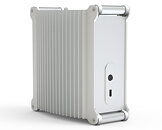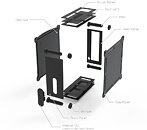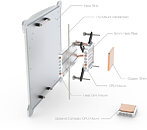Mar 30th, 2025 22:37 EDT
change timezone
Latest GPU Drivers
New Forum Posts
- Alternatives to Autodesk Fusion 360 (4)
- Future-proofing my OLED (78)
- What do you do for a living? (440)
- I'm looking for a good tool to make the 3D scanning of my mini-pc using the photogrammetry and my Kinect 2. (147)
- Question about Intel Optane SSDs (57)
- Will you buy a RTX 5090? (458)
- What is the latest game you finished or 100% (7)
- Is the futureproof gaming solution a four drive system? (23)
- Folding Pie and Milestones!! (9452)
- Looking for Palit 5090 Gamerock OC BIOS (19)
Popular Reviews
- Sapphire Radeon RX 9070 XT Pulse Review
- ASRock Phantom Gaming B850 Riptide Wi-Fi Review - Amazing Price/Performance
- Samsung 9100 Pro 2 TB Review - The Best Gen 5 SSD
- Palit GeForce RTX 5070 GamingPro OC Review
- Sapphire Radeon RX 9070 XT Nitro+ Review - Beating NVIDIA
- Assassin's Creed Shadows Performance Benchmark Review - 30 GPUs Compared
- Enermax REVOLUTION D.F. 12 850 W Review
- AMD Ryzen 7 9800X3D Review - The Best Gaming Processor
- ASRock Radeon RX 9070 XT Taichi OC Review - Excellent Cooling
- XPG LEVANTE II 360 Review
Controversial News Posts
- AMD RDNA 4 and Radeon RX 9070 Series Unveiled: $549 & $599 (260)
- MSI Doesn't Plan Radeon RX 9000 Series GPUs, Skips AMD RDNA 4 Generation Entirely (142)
- Microsoft Introduces Copilot for Gaming (124)
- AMD Radeon RX 9070 XT Reportedly Outperforms RTX 5080 Through Undervolting (119)
- NVIDIA Reportedly Prepares GeForce RTX 5060 and RTX 5060 Ti Unveil Tomorrow (115)
- Over 200,000 Sold Radeon RX 9070 and RX 9070 XT GPUs? AMD Says No Number was Given (100)
- NVIDIA GeForce RTX 5050, RTX 5060, and RTX 5060 Ti Specifications Leak (96)
- Retailers Anticipate Increased Radeon RX 9070 Series Prices, After Initial Shipments of "MSRP" Models (90)
Thursday, November 26th 2020
Streacom Announces the DB1 Case
The high-end CPU and GPU performance arms race has been pushing power and TDP limits higher but fortunately, progress is also being made for more power-efficient CPUs with much lower TDPs that still offer competitive performance thanks to improvements in their integrated graphics. Whilst there is no shortage of fanless cases on the market that can cool these lower TDP CPUs, they have been geared towards industrial applications, tend to be expensive, and offer very little in the way of design.
The DB1 is here to change that with a case that delivers all the benefits of fanless/silent computing, but in an ultra-compact form factor that once again breaks the mould of typical fanless cases. With a total volume less than 5 l (222 x 222 x 101 mm), the DB1 is our most compact fanless case but can still comfortably handle 45 W of cooling, which is ideal for power-efficient systems based on the new generation of APU/iGPUs that deliver excellent performance/watt.The DB1 is constructed from 4 mm thick aluminium panels, a 21 mm thick extruded heat sink, solid aluminium pillars and is made using CNC milling and finished with sandblasted/anodized surface treatment, but despite using these premium materials, processing and finish, is extremely competitively priced.
The beauty of the DB1 (apart from its appearance) is the simplicity of its design that used 4 solid aluminium pillars to connect the heat sink and side panel that in turn secure the front, rear, upper and lower panels in place. This approach greatly reduces complexity, combines functionality (as the pillars also serve as the feet), and mean that the entire case can be fully disassembled with just 8 screws.
This design also allows for great flexibility in orientation and placement of the case, every panel can be rotated to allow for left or right positioning and inverted orientations. The modularity also means that requirements for customization are lower, making this an excellent platform for system integrators.
With our approach to fanless, the cooling is done by the case itself and the DB1 is no exception. Using the same copper CPU shim, adjustable CPU mount and heat sink mount as our DB4, heat is transferred from the CPU to the heat sink (side panel) using 6mm copper heat pipes and dissipated into the environment along its surface and fins which are optimised for natural convection.
With the combination of the universal CPU mount and fully position adjustable heat sink mount, there are virtually no motherboard compatibility issues as the socket location is not a limiting factor and conflicts with board components are minimised.
The stock CPU mount is compatible with all current desktop sockets and there is also an optional compact CPU mount to expand that compatibility to less common sockets such as FCBGA 1667 or even more specialist soldered CPUs.
It's hard to appreciate just how small and tightly packed some our compact cases are, to the extent that we sometimes get asked if it's possible to install an SFX or even ATX PSU inside them.
For some context, the DB1 is not much larger than the ITX motherboard it holds, and this ultra small form factor is only made possible by the use of a NanoPSU that plugs directly into the motherboard.
Apart from reducing the space required, use of the Nano PSU has two other advantages,
Modularity and versatility are principles we always try to incorporate into our designs, so with the DB1 we have made all the panels interchangeable and added an option to rotate the internals by 90 degrees, allowing any variation of heat sink and front panel position/orientation.
The DB1 was of course design to work primarily in the vertical orientation as that occupies the least amount of desk space and also gives the best cooling performance as convection is optimised. It can however also be used in the horizontal orientation with the ability to position the front I/O at either side of the case. The front I/O is also modular and uses the same module as the DA2 so included Type-A 19PIN can be replaced with an optional Type-C 19PIN or 3.1 Gen2 or any future standard. This modularity and cross-platform approach is part of our wider commitment to product continuity and ensuring the case you buy today does not become obsolete when new hardware is released.
The DB1 is here to change that with a case that delivers all the benefits of fanless/silent computing, but in an ultra-compact form factor that once again breaks the mould of typical fanless cases. With a total volume less than 5 l (222 x 222 x 101 mm), the DB1 is our most compact fanless case but can still comfortably handle 45 W of cooling, which is ideal for power-efficient systems based on the new generation of APU/iGPUs that deliver excellent performance/watt.The DB1 is constructed from 4 mm thick aluminium panels, a 21 mm thick extruded heat sink, solid aluminium pillars and is made using CNC milling and finished with sandblasted/anodized surface treatment, but despite using these premium materials, processing and finish, is extremely competitively priced.
The beauty of the DB1 (apart from its appearance) is the simplicity of its design that used 4 solid aluminium pillars to connect the heat sink and side panel that in turn secure the front, rear, upper and lower panels in place. This approach greatly reduces complexity, combines functionality (as the pillars also serve as the feet), and mean that the entire case can be fully disassembled with just 8 screws.
This design also allows for great flexibility in orientation and placement of the case, every panel can be rotated to allow for left or right positioning and inverted orientations. The modularity also means that requirements for customization are lower, making this an excellent platform for system integrators.
With our approach to fanless, the cooling is done by the case itself and the DB1 is no exception. Using the same copper CPU shim, adjustable CPU mount and heat sink mount as our DB4, heat is transferred from the CPU to the heat sink (side panel) using 6mm copper heat pipes and dissipated into the environment along its surface and fins which are optimised for natural convection.
With the combination of the universal CPU mount and fully position adjustable heat sink mount, there are virtually no motherboard compatibility issues as the socket location is not a limiting factor and conflicts with board components are minimised.
The stock CPU mount is compatible with all current desktop sockets and there is also an optional compact CPU mount to expand that compatibility to less common sockets such as FCBGA 1667 or even more specialist soldered CPUs.
It's hard to appreciate just how small and tightly packed some our compact cases are, to the extent that we sometimes get asked if it's possible to install an SFX or even ATX PSU inside them.
For some context, the DB1 is not much larger than the ITX motherboard it holds, and this ultra small form factor is only made possible by the use of a NanoPSU that plugs directly into the motherboard.
Apart from reducing the space required, use of the Nano PSU has two other advantages,
- It reduces the amount of heat being dumped inside the case as the AC to DC conversion is happening in the external AC adapter, and
- It is fanless, no need to expand on how important that is for a fanless system
Modularity and versatility are principles we always try to incorporate into our designs, so with the DB1 we have made all the panels interchangeable and added an option to rotate the internals by 90 degrees, allowing any variation of heat sink and front panel position/orientation.
The DB1 was of course design to work primarily in the vertical orientation as that occupies the least amount of desk space and also gives the best cooling performance as convection is optimised. It can however also be used in the horizontal orientation with the ability to position the front I/O at either side of the case. The front I/O is also modular and uses the same module as the DA2 so included Type-A 19PIN can be replaced with an optional Type-C 19PIN or 3.1 Gen2 or any future standard. This modularity and cross-platform approach is part of our wider commitment to product continuity and ensuring the case you buy today does not become obsolete when new hardware is released.
- The DB1 will be available with resellers in Q1 2021 to retail for ~ 109EUR / 129USD.
- The Nano90 will be available at the same time with a retail price of ~ 68EUR / 79USD.
Mar 30th, 2025 22:37 EDT
change timezone
Latest GPU Drivers
New Forum Posts
- Alternatives to Autodesk Fusion 360 (4)
- Future-proofing my OLED (78)
- What do you do for a living? (440)
- I'm looking for a good tool to make the 3D scanning of my mini-pc using the photogrammetry and my Kinect 2. (147)
- Question about Intel Optane SSDs (57)
- Will you buy a RTX 5090? (458)
- What is the latest game you finished or 100% (7)
- Is the futureproof gaming solution a four drive system? (23)
- Folding Pie and Milestones!! (9452)
- Looking for Palit 5090 Gamerock OC BIOS (19)
Popular Reviews
- Sapphire Radeon RX 9070 XT Pulse Review
- ASRock Phantom Gaming B850 Riptide Wi-Fi Review - Amazing Price/Performance
- Samsung 9100 Pro 2 TB Review - The Best Gen 5 SSD
- Palit GeForce RTX 5070 GamingPro OC Review
- Sapphire Radeon RX 9070 XT Nitro+ Review - Beating NVIDIA
- Assassin's Creed Shadows Performance Benchmark Review - 30 GPUs Compared
- Enermax REVOLUTION D.F. 12 850 W Review
- AMD Ryzen 7 9800X3D Review - The Best Gaming Processor
- ASRock Radeon RX 9070 XT Taichi OC Review - Excellent Cooling
- XPG LEVANTE II 360 Review
Controversial News Posts
- AMD RDNA 4 and Radeon RX 9070 Series Unveiled: $549 & $599 (260)
- MSI Doesn't Plan Radeon RX 9000 Series GPUs, Skips AMD RDNA 4 Generation Entirely (142)
- Microsoft Introduces Copilot for Gaming (124)
- AMD Radeon RX 9070 XT Reportedly Outperforms RTX 5080 Through Undervolting (119)
- NVIDIA Reportedly Prepares GeForce RTX 5060 and RTX 5060 Ti Unveil Tomorrow (115)
- Over 200,000 Sold Radeon RX 9070 and RX 9070 XT GPUs? AMD Says No Number was Given (100)
- NVIDIA GeForce RTX 5050, RTX 5060, and RTX 5060 Ti Specifications Leak (96)
- Retailers Anticipate Increased Radeon RX 9070 Series Prices, After Initial Shipments of "MSRP" Models (90)





13 Comments on Streacom Announces the DB1 Case
Making a case small because it can't fit everything you would expect in it isn't really helpful, it's just a misleading disappointment.
And even though normally, the lack of USB-C on the front is also a no-buy for me, at least they made it an available option, unlike most of the other 1.67431 gazillion so-called "NEW" cases released this year...:D
I use www.chieftec.eu/de/geh%C3%A4use/itx/uni-serie/bu-12b.html
While it is bigger than DB1, it has space for everything. i5-10500 with HTPC200 cooler. 3x SSD inside the case. Intake 80mm fan. 10gb pci-e nic.
It sits comfortably behind the TV. Makes no sound (well at least the one that could be heard from 50cm away)
wow, its even bigger no no, once i saw that power brick and nano psu are not included.
I'm not sure why having a brick is such a bad idea? It tops out at 80 W anyway.
The PSU problem is another story.
I wish they made passive TFX psu. But i guess it would cost over 100 eur, just because its passive, while passive power bricks cost like 20 eur. Seems like its a rocket science to combine pico PSU with a power brick to make a passive 100W~ TFX psu meant for low power systems like these.
It's a nice looking case, but as someone who hates power bricks, it's a no-go for me.
Like you say, if thermals are a problem, use an adhesive thermal pad. The external bricks are already passively cooled and covered in thermally-insulating plastic, so they can't get that hot if their housing is physically heatsinked....
It'd be nice if there was a standard but these cases are all kind of proprietary in some way, so having intelligent layouts (such as an integrated PSU brick bay by default is more important than ever. Based on replies in this thread, the external brick is a massive issue that immediately excludes this product from consideration for many in the target market, and playing the armchair engineer (I am an actual, qualified engineer but that's not the point) it wouldn't be that difficult or expensive to actually implement.